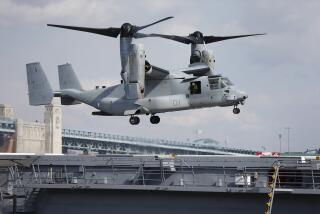Capitol Hill Has ‘Sticker Shock’ Over B-2
- Share via
WASHINGTON — The Air Force Wednesday apparently failed to win new Capitol Hill converts for its $70-billion stealth bomber program. Instead, the service learned that congressional “sticker shock” could kill or cripple the program before it has completed its first round of tests.
The Pentagon’s proposed yearly bill for the bomber soon will surpass the annual defense budgets of all but 12 nations in the world. The annual cost by 1992 is expected to hit $8 billion. The $4.7 billion proposed for next year exceeds spending on “Star Wars” research, said Rep. Les Aspin (D-Wis.), chairman of the House Armed Services Committee.
“Is it conceivable we’re going to do this? No chance. No chance,” Aspin said at the briefing before his committee Wednesday.
Rep. William L. (Bill) Dickinson (R-Ala.), the panel’s ranking Republican, echoed Aspin’s frustration.
“It ain’t going to happen,” said Dickinson. “When the chairman tells you politically you ain’t going to see 6, 7, 8 billion, you can put it in your pocket and take it to the bank.”
But Air Force Secretary Donald B. Rice said that “despite the sticker shock,” the B-2 bomber is the “most efficient option available” to threaten well-defended Soviet targets.
“Yes, the cost is high, but that has to be put in the context of the challenge” of penetrating future Soviet air defenses, Rice said.
The Pentagon plans to build 132 of the boomerang-shaped bombers, which are designed to be virtually invisible to Soviet air defense radars. The aircraft, which Defense Secretary Dick Cheney lauded recently as a design “revolution,” is intended to attack command posts and moving targets with some 50,000 pounds of nuclear bombs.
As congressional opposition to the plane has grown, the Air Force has offered once-secret details on the cost and capabilities of the plane.
In their second day before the committee, the Air Force officials took pains to portray the bombers as a bargain at $274 million each when compared to the alternatives.
With $23 billion already invested in the development and early production of the plane, it will take $43 billion to complete the program, Rice said. If Congress were to scrap the B-2 and order enough current-generation B-1 bombers to perform the mission, it would cost $60 billion, he said. The resulting force of B-1 bombers still would be less capable than the B-2 bombers, Rice added.
The Pentagon’s first public airing of the B-2 briefing came just two days after the plane emerged from its Northrop Corp. hangar to begin flight tests. The plane is expected to make its maiden flight within the next 12 days.
Rice and Gen. Larry D. Welch, the Air Force chief of staff, told House lawmakers that if any major technical flaws in the innovative aircraft exist, they will surface during the plane’s first, six-month series of tests. The service will not make commitments to spend approved 1990 funds before those tests end, Rice said.
But Rice and Welch warned that efforts to delay the program further while flight tests proceed would only increase the price of each plane. If Congress refuses 1990 production funds in an effort to allow further testing, Welch said, the program could end up costing an extra $4.2 billion.
Aspin’s committee already has agreed to slash $800 million from the stealth bomber program in 1990, shifting the funds to other programs favored by lawmakers. The Senate Armed Services Committee, which received the Air Force briefing Tuesday, is to draft the bomber-related portion of its 1990 defense funding bill today.
More to Read
Sign up for Essential California
The most important California stories and recommendations in your inbox every morning.
You may occasionally receive promotional content from the Los Angeles Times.














